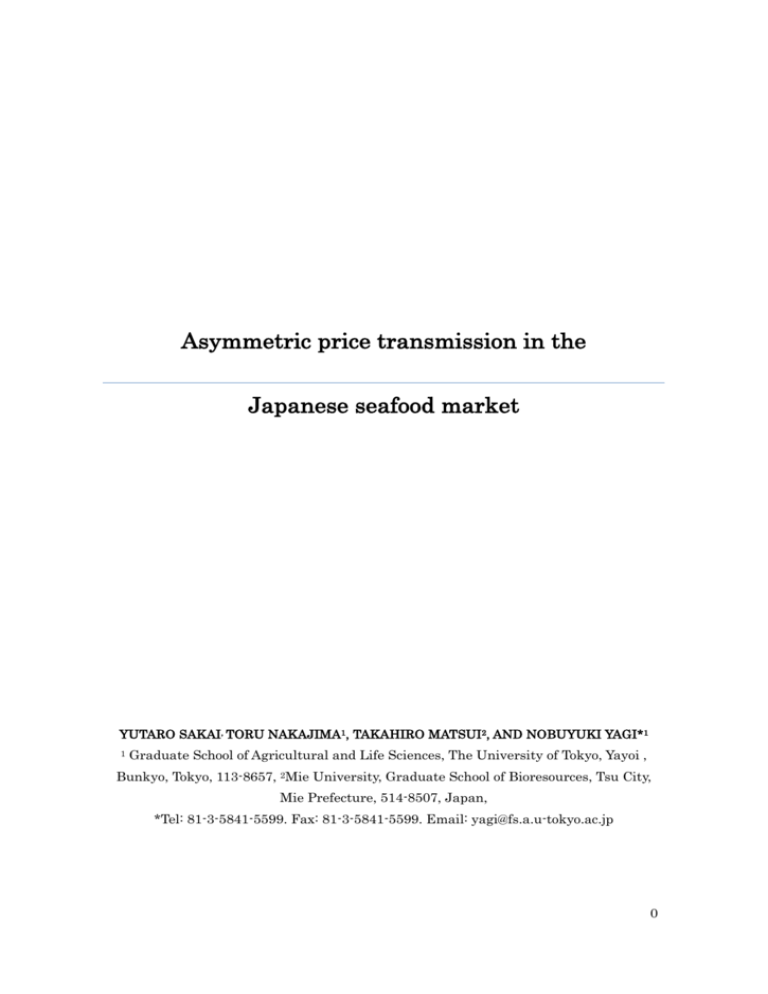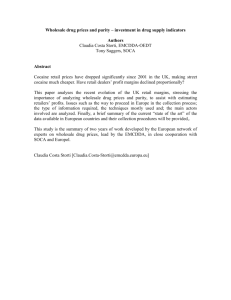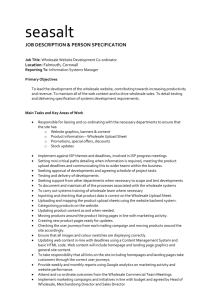Asymmetric price transmission in the Japanese seafood market
advertisement

Asymmetric price transmission in the Japanese seafood market YUTARO SAKAI, TORU NAKAJIMA1, TAKAHIRO MATSUI2, AND NOBUYUKI YAGI*1 1 Graduate School of Agricultural and Life Sciences, The University of Tokyo, Yayoi , Bunkyo, Tokyo, 113-8657, 2Mie University, Graduate School of Bioresources, Tsu City, Mie Prefecture, 514-8507, Japan, *Tel: 81-3-5841-5599. Fax: 81-3-5841-5599. Email: yagi@fs.a.u-tokyo.ac.jp 0 Summary Japanese seafood distribution consists of three levels of market, namely producer’s, wholesale and retailers market. This system has developed to manage a large quantity of diverse seafood products rapidly, but its function is said to have been imperfect. The study mainly focused on six fish species namely Japanese sardine, horse mackerel, Japanese flying squid, skipjack tuna, Pacific saury, and red seabream. This study analysed the price formation function of the Japanese seafood distribution for the six major fish species through asymmetric price transmission (APT) analysis. The results indicated that there were several APTs in the market most likely due to a combined effect of perishable nature of fisheries products, existence of substitute goods, and imperfect completion of the market. Key words: asymmetric price transmission (APT), market competition, price formation, seafood distribution, Japan. 1 Table of Contents 1. Introduction ................................................................................................ 3 2. Materials and Methods .............................................................................. 3 3. Data............................................................................................................. 5 4. Unit root test .............................................................................................. 7 5. Analysis model.......................................................................................... 10 6. Results ...................................................................................................... 12 7. Discussion ................................................................................................. 18 Reference ......................................................................................................... 22 2 1. Introduction Japanese seafood products are traditionally distributed through three markets namely landing site producers’ market, consuming site wholesale markets, and retailers. This distribution system has developed to manage a large quantity of diverse seafood products rapidly. Recently, however, several shortcomings of the traditional distribution system are pointed out. Lou(2009)1) pointed out restructuring the markets is urgent and fishermen, wholesales and brokers must leave their traditional distribution system and create a new business. While most of such arguments are based on qualitative observations, a few quantitative studies also exist. Ariji(2006)2) analysed market integration of snow crab between landing markets and wholesales markets in Kyoto prefecture. The focus of this study was the extent of the integration of prices in different markets and it didn’t refer to function of distribution in detail. Therefore the quantitative knowledge about the function of Japanese seafood distribution system is still insufficient. The purpose of this study is to analyze the function of Japanese seafood distribution from the view of price formation. 2. Materials and Methods 2.1 Asymmetric price transmission (APT) In the economically perfect competitive market, when the exogenous shock against the market equilibrium happens, it is said the price is adjusted instantly and new equilibrium occurs. In the real market, however, price will never be adjusted instantly. The speed of adjustment can be different from price increasing scenario to price decreasing scenario. Thus, Asymmetric price transmission (APT) can be detected under such situation. Positive APT is usually defined as a set of reactions according to which any price 3 movement that squeezes the margin is transmitted more rapidly than the equivalent movement that stretches the margin. Conversely, APT is negative when price movements that stretch the margin are transmitted more rapidly than movements that squeeze it. Gonzales et al.(2003)3) detected the APT in the distribution of wild cod and farmed salmon and made a comment that the reason of APT is due to market power of retailer. Jaffry(2005)4) detected the APT in the distribution of hakes in France and made the same comment as Gonzales referring to retailer’s market power. Matsui et al.(2011)5) analysed Japanese blue fin tuna market by separating the target period in ten years and discussed that entities having the market power shifted from upstream to downstream by tuna market structure change. Some other studies argued that a cause of the asymmetry price transmission is due to a property of the adjustment expense with the corporate activities. Ward (1982)6) pointed out that the price of perishable agricultural products cannot be raised as easily as decreasing the price. Jordi and Ramon(2008)7) analyzed three stages of distribution called a producer’s, consumer’s and retailer’s market of 12 seafood products in Spain and detected APTs with many cases. They discussed that the cause is not due to imperfect competitive market but due to the existence of substitute products in the lower side of the distribution channel. In this study, we used time series model to detect a presence of asymmetry price transmission. The focus was mainly on (i) landing site producers’ markets, (ii) consuming site wholesale markets and (iii) retailers. Price transmission between (i) and (ii), as well as (ii) and (iii) were examined using the price data of same fish species. We also conducted a time wise comparison using the price date of same fish species on or before 1993 and thereafter. The dividing year was chosen based on Demura(2002)8) which reported that in 1994 the number of consumers who purchase seafood from supermarkets exceeded to those who purchase seafood in traditional fish mongers. 4 2.2 Data Six popular fish species in the Japanese market were chosen for the analysis. These are Japanese sardine, horse mackerel, Japanese flying squid, skipjack tuna, Pacific saury, and red seabream. Although tuna is popular fish in Japan, it is not used for the analysis because of data discontinuation i.e. frequent changes on categorisation of tuna (i.e., coverage of tuna species) in market statistics during this past 20 years. The price data are collected in three different stages in the market value chain. These are (i) producer’s markets in landing ports, (ii) wholesale markets in consumer’s cities and (iii) retailers. Fish prices in (i) and (ii) were taken from published data from the Ministry of Agriculture, Forestry and Fisheries, Japan9) and retailer’s prices were taken from statistics of Ministry of Internal Affairs and Communications, Japan10). For some species, prices for fresh and frozen forms of fish are available. If this is the case, weighted averages of the prices for fresh and frozen fish were used for the analysis. Fish which were once frozen and then thawed are categorized as fresh in the statistics. Wholesale market prices are the weighted mean of the prices of the six main wholesale markets in Japan (Tokyo, Yokohama, Nagoya, Osaka, Kyoto, Kobe). The retail price was calculated by the simple average of the retail prices in Tokyo, Yokohama, Nagoya, Osaka, Kyoto, and in Kobe. Monthly data are used for analysis. Data are taken from January 1976 to December 2009 for Japanese sardine, horse mackerel, Pacific saury, and common squid. The data used for red seabream are from January 1976 to December 2006. For skipjack tuna, the data from January 1983 to December 2009 are used. Time series of data used for Seabream and skipjack tuna are slightly shorter than those in other species, since statistical categories have been changed for these two species and only the data which have clear 5 consistency in category are used for the analysis of the two species. No data were used for "the frozen saury in Kyoto”, "frozen common squid in Yokohama", and "frozen horse mackerel after September 2005”. This is because several products in different processing stages were found under the same name in the statistics of these particular fish. In addition, since skipjack tuna statistics in retail level were not available in winter seasons (from November to February), retail prices for skipjack tuna for these months are supplemented using Karman filter method11). Table 1 indicates some details of these data. Red seabream generally have higher prices than other fish, and the average prices at wholesale markets are more than 1,000 yen/kg and the average price at retail markets is above 3,000 yen/kg. Skipjack tuna has the second highest average price in retail markets with more than 2,000 yen/kg. Prices for other four species are cheaper. Generally, price of each fish species increases from wholesale to retail markets. Table 1 Descriptive statistics Variable (Yen/kg) Mean S.D. Min Max Producer 73.53 112.15 9.00 822.00 Wholesale 248.40 126.50 92.00 666.64 Retail 643.61 280.39 281.67 1326.67 Producer 289.60 183.34 34.00 1030.00 Wholesale 514.68 84.94 292.46 866.88 Retail 1598.48 239.68 915.00 2356.67 Producer 315.93 138.75 99.19 867.95 Wholesale 467.28 101.69 262.87 790.97 Retail 1027.85 186.52 666.67 1576.67 174.09 41.92 91.42 310.09 Sardine Horse mackerel Japanese flying squid Skipjack tuna Producer 6 Wholesale 585.87 185.40 244.00 1232.74 Retail 2346.15 362.28 1436.67 3183.33 Producer 187.61 211.54 29.00 2027.00 Wholesale 390.54 155.91 157.23 1106.70 Retail 1015.48 282.42 566.67 2606.67 Producer 1287.68 337.35 630.00 2181.00 Wholesale 1429.60 414.36 715.62 2399.00 Retail 3044.80 433.35 2150.00 3751.67 Pacific saury Red seabream Producer: Producer’s wholesale market price, Wholesale: Wholesale’s wholesale market price, Retail: Retail market price. Producer’s price and wholesale’s price were obtained from Annual Statistics on Marketing of Fishery Products. Retail price was obtained from Annual Report on the Retail Price Survey. 2.3 Unit root test In time series analyses, there is a situation where a high coefficient and a significant t-value can be observed while no true relationship in fact exist12). In other words, spurious regression is more likely to be detected when time series data was used. To avoid picking up spurious correlations, unit root test and co-integration test are to be employed. As for unit root test, Augmented Dickey-Fuller test13) and Kwiatkovski-Phillips-Schmidt-Shin (KPSS) test14) were conducted before starting price transmission analysis. The results are shown in Table 2. The null hypothesis, which assumes variables are non-stationary, can be dismissed for almost all price data. For many of the first difference, the null hypothesis was not rejected by 1% significance. This result suggests that every price data series are non-stationary but becomes stationary by first difference. Thus, co-integration test, which examines whether true relations exist between non-stationary data15), needs to be performed to confirm the estimated result have true relationship. 7 Table 2 Unit root test results (a) Augmented Dickey-Fuller test Level Variable Trend Const. Trend First difference None Trend Const. Trend None Sardine Producer -2.02 -1.29 -0.68 -21.34*** -21.36*** -21.39*** Wholesale -1.59 -1.11 0.45 -23.27*** -23.30*** -23.32*** Retail -0.87 -1.10 1.08 -14.08*** -14.09*** -14.09*** -2.84 -1.78 -1.30 -20.94*** -20.97*** -20.99*** Wholesale -4.22*** -2.45 -0.31 -22.99*** -23.01*** -23.03*** Retail -5.21*** -2.38 -0.14 -25.23*** -25.23*** -25.26*** Horse mackerel Producer Japanese flying squid Producer -3.13 -1.90 -1.14 -18.29*** -18.31*** -18.33*** Wholesale -3.32* -2.39 -0.75 -20.09*** -20.11*** -20.13*** Retail -3.16* -1.74 -0.45 -16.21*** -16.22*** -16.24*** -3.64** -3.57*** -0.75 -20.80*** -20.84*** -20.87*** Wholesale -2.62 -2.54 -0.12 -16.40*** -16.42*** -16.45*** Retail -1.76 -1.96 0.07 -14.12*** -14.14*** -14.16*** -2.62 -2.63* -1.36 -27.22*** -27.26*** -27.29*** -3.65** -3.59*** -1.33 -23.77*** -23.79*** -23.82*** -4.20*** -4.16*** -0.81 -24.94*** -24.97*** -25.00*** Producer -3.10 -0.82 -1.34 -22.77*** -22.80*** -22.83*** Wholesale -2.98 -1.50 -1.08 -23.93*** -23.96*** -23.98*** -4.16*** 0.05 -1.22 -20.33*** -20.35*** -20.37*** Skipjack tuna Producer Pacific saury Producer Wholesale Retail Red seabream Retail * 10% significance level. ** 5% significance level. *** 1% significance level. Producer: Producer’s wholesale market price, Wholesale: Wholesale’s wholesale market price, Retail: Retail market price. Optimal lag length was determined by modified Akaike Information Criteria. 8 (b) Kwiatkovski-Phillips-Schmidt-Shin test Level Variable Trend Const. First difference Const. Trend Const. Const. Sardine Producer 0.43*** 1.92*** 0.05 0.11 Wholesale 0.23*** 2.36*** 0.12 0.15 Retail 0.25*** 2.42*** 0.12 0.16 0.38*** 1.88*** 0.09 0.09 0.11 1.38*** 0.11 0.24 0.20** 1.07*** 0.13* 0.33 0.27*** 1.93*** 0.07 0.07 0.11 1.38*** 0.06 0.08 0.23*** 1.52*** 0.06 0.14 0.10 0.37* 0.27*** 0.28 0.21** 0.36* 0.10 0.11 0.50*** 0.60** 0.06 0.06 Producer 0.10 0.25 0.21** 0.26 Wholesale 0.12* 0.31 0.05 0.07 Retail 0.12* 0.13 0.04 0.11 Producer 0.24*** 2.13*** 0.12* 0.13 Wholesale 0.20** 2.11*** 0.06 0.06 0.46*** 2.13*** 0.08 0.17 Horse mackerel Producer Wholesale Retail Japanese flying squid Producer Wholesale Retail Skipjack tuna Producer Wholesale Retail Pacific saury Red seabream Retail * 10% significance level. ** 5% significance level. *** 1% significance level. Producer: Producer’s wholesale market price, Wholesale: Wholesale’s wholesale market price, Retail: Retail market price. Optimal Newey-West bandwidth was determined using Bartlett kernel. The null hypothesis is that the time series is stationary; while the alternative hypothesis is that the series is non-stationary. Note that the hypothesis setting of KPSS test is different from that of ADF test. 9 2.4 Analysis model When the price series have unit root, the long-term relationship can be described as follows: 𝑌𝑡 = α + β𝑋𝑡 + 𝜇𝑡 (1) 𝑌𝑡 is market price of the lower side (e.g., closer position to consumers) of the fish distribution channel, and 𝑋𝑡 is market price of the upper side (e.g., closer position to producers) of the channel. When the time series data on the two prices are non-stationary, the estimation using Ordinary Least-Squares method (OLS) could result in spurious regression. According to Engle and Granger(1987)15), when a residual 𝜇𝑡 provided by estimation is stationary, the estimated result is not spurious but represents true relations. The estimation in this analysis therefore should be conducted using equation (2): ∆𝜇𝑡 = 𝜌1 𝜇𝑡−1 + ∑𝑇𝑖=1 𝛾𝑖 ∆𝜇𝑡−𝑖 + 𝜀𝑡 (2) 𝑇 is the length of the lag and 𝜀𝑡 is white noise disturbance term. Adjustment of the series of residuals from previous period to the current period will be expressed in 𝜌1 𝜇𝑡−1 and it means that APT price adjustment process in the market is assumed to be symmetric against any exogenous shocks. If a price adjustment process is asymmetric, the Threshold Autoregressive (TAR) model, proposed by Enders and Granger(1998)14), needs to be used to avoid estimation bias. In this model, co-integration test is conducted by equation (3) instead of equation (2): ∆𝜇𝑡 = 𝐼𝑡 𝜌1 𝜇𝑡−1 + (1 − 𝐼𝑡 )𝜌2 𝜇𝑡−1 + ∑𝑇𝑖=1 𝛾𝑖 ∆𝜇𝑡−𝑖 + 𝜀𝑡 (3) 10 1 if t 1 It 0 if t 1 (4) 𝐼𝑡 is called Heaviside indicator and the definition is shown in equation (4). Suppose that 𝜇𝑡−1 is bigger than the threshold τ, adjustment of this period is shown in 𝜌1 𝜇𝑡−1 . If 𝜇𝑡−1 is smaller than the threshold τ, adjustment of this period is shown in 𝜌2 𝜇𝑡−1 . When 𝜌1 = 𝜌2 is hold, it means that the adjustment process is symmetric and, in this case, equation (3) can also represent equation (2) Under equation (3), the necessary and sufficient condition for the stationary residual series can be shown in the following equation (5)16): (5) 𝜌1 < 0 , 𝜌2 < 0, (1 + 𝜌1 )(1 + 𝜌2 ) < 1 In equation (5), a null hypothesis ( 𝜌1 = 𝜌2 = 0 ) under no existence of co-integration can be examined through F-test modified by Engle and Siklos(2001)17) and Wane et al.(2004)18). If there is co-integration, normal F-test can be used to examine the null hypothesis on symmetric adjustment process (𝜌1 = 𝜌2 ). In addition to the TAR model, Momentum-Threshold Autoregressive (M-TAR) model have been used. It is sometimes suggested that M-TAR model is more suitable than TAR model for the analysis on perishable products such as foods19) M-TAR model can be expressed as follows: ∆𝜇𝑡 = 𝑀𝑡 𝜌1 𝜇𝑡−1 + (1 − 𝑀𝑡 )𝜌2 𝜇𝑡−1 + ∑𝑇𝑖=1 𝛾𝑖 ∆𝜇𝑡−𝑖 + 𝜀𝑡 1 if t 1 Mt 0 if t 1 (6) (7) In this study, estimations are made using both TAR and M-TRA model and the better model will be chosen in light of Akaike information criterion (AIC). Many previous studies assumed the threshold is 0 a priori, while the validity of this assumption is not fully examined. In this study, the estimation of the 11 threshold itself also was performed by the procedures suggested in Chan (1993)20). Specifically, we start the estimation process using Equation (1) by normal OLS. Then, residuals obtained here are listed, and the upper and the lower 15% of them are removed. The remaining 70% of the residual values could be a candidate of the threshold. These candidates are used for the estimation by TAR and M-TAR model. The candidate which minimizes the sum of the squared residuals is chosen. The threshold chosen by this procedure becomes the super-consistent indicator. 3. Results The estimated results of six species by both TAR and M-TAR model are shown in Table 3 and Table 4. Table 3 TAR model result (a) Producer’s to wholesale’s wholesale market First period (-1993) Sardine Horse Japanese Skipjack Pacific Red mackerel flying squid tuna saury seabream 𝜌1 -0.08 -0.27*** -0.37*** -0.38*** -0.09** -0.27*** 𝜌2 -0.20 -0.18*** -0.25*** -0.29*** -0.39*** -0.05 Lags 2 0 0 1 0 3 𝜏 -0.18 -0.10 -0.10 0.13 -0.35 -0.08 Hypotheses test: Φ 7.32** 32.10*** 47.18*** 16.64*** 37.60*** 7.57** Asym. 2.53 1.16 1.49 0.60 12.81*** 6.59** Q(6) 6.23 6.41 3.63 5.24 9.86 9.37 AIC -127.09 -233.71 -226.09 -41.39 -56.18 -247.81 Diagnostic: Second period (1994-) Sardine 𝜌1 -0.58*** Horse Japanese Skipjack Pacific Red mackerel flying squid tuna saury seabream -0.72*** -0.48*** -0.83*** -0.23*** -0.34*** 12 𝜌2 -0.49*** -0.68*** -0.41*** -0.68*** -0.39*** -0.27*** Lags 0 1 0 4 0 0 𝜏 0.13 0.10 0.09 0.29 -0.28 0.08 Hypotheses test: Φ 69.85*** 44.96*** 55.71*** 41.59*** 14.03*** 30.48*** Asym. 0.41 0.07 0.35 2.12 3.97** 0.30 Q(6) 9.14 5.59 4.67 4.48 14.69 4.05 AIC -116.57 -193.35 -148.17 -18.66 -3.57 -188.65 Diagnostic: * 10% significance level. ** 5% significance level. *** 1% significance level. Φ is the F statistics testing the null hypothesis of 𝜌1 = 𝜌2 = 0. Asym. is the F statistics testing the null hypothesis of 𝜌1 = 𝜌2. Q(6) is the Ljung-Box Q statistics testing the null hypothesis of no serial correlation up to six orders. AIC is the Akaike Information Criteria. (b) Wholesale’s wholesale to retail market First period (-1993) Sardine Horse Japanese Skipjack Pacific Red mackerel flying squid tuna saury seabream 𝜌1 -0.34*** -0.23*** -0.43*** -0.20** -0.11** -0.45*** 𝜌2 -0.23*** -0.11* -0.21*** -0.37*** -0.19** -0.19*** Lags 0 4 3 2 1 0 𝜏 0.07 -0.11 0.12 0.08 -0.13 -0.03 Hypotheses test: Φ 36.04*** 6.20* 24.11*** 7.81** 8.27** 50.66*** Asym. 1.37 1.56 7.94*** 1.75 0.98 6.83*** Q(6) 10.11 0.66 1.56 4.41 10.23 4.51 AIC -241.46 -241.51 -279.66 -142.83 -238.55 -444.81 Diagnostic: Second period (1994-) Sardine Horse Japanese Skipjack Pacific Red mackerel flying squid tuna saury seabream 𝜌1 -0.62*** -0.41*** -0.66*** -0.31*** -0.49*** -0.25*** 𝜌2 -0.28*** -0.18** -0.37*** -0.14 -0.79*** -0.07 Lags 1 3 3 0 1 1 13 𝜏 -0.07 0.03 -0.10 -0.11 -0.10 0.06 Hypotheses test: Φ 22.78*** 7.86** 41.15*** 28.96*** 26.63*** 8.92** Asym. 6.91*** 3.48* 8.41*** 3.33* 3.55* 5.18** Q(6) 6.52 1.86 4.58 7.67 4.11 2.10 AIC -232.21 -313.29 -238.90 -245.69 -151.51 -331.61 Diagnostic: * 10% significance level. ** 5% significance level. *** 1% significance level. Φ is the F statistics testing the null hypothesis of 𝜌1 = 𝜌2 = 0. Asym. is the F statistics testing the null hypothesis of 𝜌1 = 𝜌2. Q(6) is the Ljung-Box Q statistics testing the null hypothesis of no serial correlation up to six orders. AIC is the Akaike Information Criteria. The estimated results of TAR model can be summarized as follows: Ljung-Box statistic values are insignificant for all cases thus, the residuals do not have serial correlation for all the 24 combinations of six spices, two observation periods, and two combinations of market stages in value chain. Lag numbers are 0 to 4 for each fish. Φ statistic values are significant in 17 cases out of the 24 combinations by 1% significant level, while by 10% level all are significant. Thus, all price series have co-integration. APTs are identified between producer’s and consumer’s wholesale market for saury and red seabream in early period (-1993) and saury in the late period (1994-). APTs are also identified between consumer’s wholesale market and retailers for common squid and red seabream in early period (-1993) and for all the six species in the late period (1994-). 14 Table 4 M-TAR model result (a) Producer’s to wholesale’s wholesale market First period (-1993) Sardine Horse Japanese Skipjack Pacific Red mackerel flying squid tuna saury seabream 𝜌1 -0.09** -0.29*** -0.35*** -0.39*** -0.80*** -0.18*** 𝜌2 -0.30*** -0.20*** -0.25** -0.20* -0.17*** -0.06 Lags 2 0 0 1 0 3 𝜏 -0.11 -0.02 -0.09 -0.10 0.26 -0.02 Hypotheses test: Φ 8.81** 39.03*** 45.99*** 17.69*** 34.75*** 5.09 Asym. 5.35** 1.04 0.51 2.27 9.80*** 1.84 Q(6) 5.40 6.15 4.18 6.02 6.25 10.22 AIC -128.50 -236.58 -224.31 -42.23 -54.44 -245.43 Diagnostic: Second period (1994-) Sardine Horse Japanese Skipjack Pacific Red mackerel flying squid tuna saury seabream 𝜌1 -0.74*** -0.90*** -0.49*** -0.95*** -0.25*** -0.43*** 𝜌2 -0.42*** -0.67*** -0.37*** -0.66*** -0.39*** -0.21*** Lags 0 1 0 4 0 0 𝜏 0.13 0.10 -0.04 0.17 -0.09 0.05 Hypotheses test: Φ 74.55*** 46.42*** 55.91*** 45.05*** 9.88** 30.46*** Asym. 5.55** 2.04 0.82 6.92*** 1.62 3.40* Q(6) 8.08 4.89 4.26 4.06 11.84 5.92 AIC -117.97 -194.35 -147.64 -21.08 -3.38 -189.14 Diagnostic: * 10% significance level. ** 5% significance level. *** 1% significance level. Φ is the F statistics testing the null hypothesis of 𝜌1 = 𝜌2 = 0. Asym. is the F statistics testing the null hypothesis of 𝜌1 = 𝜌2. Q(6) is the Ljung-Box Q statistics testing the null hypothesis of no serial correlation up to six orders. AIC is the Akaike Information Criteria. 15 (b) Wholesale’s wholesale to retail market First period (-1993) Sardine Horse Japanese Skipjack Pacific Red mackerel flying squid tuna saury seabream 𝜌1 -0.35*** -0.30*** -0.24*** -0.23*** -0.11** -0.47*** 𝜌2 -0.13*** -0.11* -0.66*** -0.71*** -0.55*** -0.30*** Lags 0 4 2 2 2 0 𝜏 -0.04 0.05 -0.09 -0.12 -0.09 0.03 Hypotheses test: Φ 40.56*** 7.38* 21.62*** 10.41*** 13.48*** 47.03*** Asym. 4.78** 3.80* 5.41** 6.44** 12.66*** 1.92 Q(6) 8.52 0.67 3.23 5.07 8.14 5.42 AIC -242.94 -242.65 -279.64 -145.17 -244.60 -441.31 Diagnostic: Second period (1994-) Sardine Horse Japanese Skipjack Pacific Red mackerel flying squid tuna saury seabream 𝜌1 -0.73*** -0.69*** -0.50*** -0.62*** -0.46*** -0.10*** 𝜌2 -0.44*** -0.38*** -0.61*** -0.20*** -1.32*** -0.26*** Lags 0 0 3 1 1 1 𝜏 0.04 0.05 -0.02 0.08 -0.07 -0.05 Hypotheses test: Φ 76.91*** 61.09*** 36.25*** 18.56*** 37.23*** 7.29* Asym. 4.79** 4.41** 1.35 10.18*** 20.36*** 2.17 Q(6) 10.25 10.63 4.32 7.14 2.23 1.49 AIC -229.86 -311.86 -235.37 -247.55 -159.54 -330.11 Diagnostic: * 10% significance level. ** 5% significance level. *** 1% significance level. Φ is the F statistics testing the null hypothesis of 𝜌1 = 𝜌2 = 0. Asym. is the F statistics testing the null hypothesis of 𝜌1 = 𝜌2 . Q(6) is the Ljung-Box Q statistics testing the null hypothesis of no serial correlation up to six orders. AIC is the Akaike Information Criteria. 16 The estimated results of M-TAR model can be summarized as follows: Ljung-Box statistic values are also insignificant in all the cases and there are no serial correlations in the residuals. The number of lag is also 0 to 4 for each fish. Φ statistic values are significant in 19 cases out of 24 combinations by 1% significant level, while 23 cases are significant by 10% level. Therefore price series have co-integration relationship in most of the cases except for one case for red seabream. APTs are identified between producer’s and consumer’s wholesale market for saury and Japanese sardine in early period (-1993) and saury, red seabream, and skipjack tuna in the late period (1994-). APTs are also identified between consumer’s wholesale market and retailers for five species except for red seabream in early period (-1993) and for four species except for seabream and common squid in the late period (1994-). Some inconformity exists between the results of APT by TAR and M-TAR models. Thus, the model, which has the smaller AIC, was chosen for each fish species. Table 5 shows the results sorted out by this procedure. APTs are identified between producer’s and consumer’s wholesale market for saury (positive APT), sardine (positive APT), and red seabream (negative APT) in early period (-1993) and saury (positive), red seabream (negative), skipjack tuna (negative), and sardine (negative) in the late period (1994-). APTs are also identified between consumer’s wholesale market and retailers for all species in early period (-1993) and in the late period (1994-). Positive and negative APT are defined as follows according to Meyer and Cramon-Taubadel(2004)21). When upper market price is increased or decreased, the positive APT is defined that the reaction of lower market price is faster in increased price scenario than in decreased price scenario. The negative APT definition is that the reaction in the lower market price is faster when decreased than when increased. When positive APT exists, the upper sellers can enjoy the sales margin while the lower buyers can enjoy the 17 margin in the negative APT situation. According to the definition in the TAR and M-TAR model, when |𝜌1 | < |𝜌2 | the positive APT exists and when |𝜌1 | > |𝜌2 | the negative APT exists In this study, while other 5 species have negative APT in most of the cases, saury always had positive APT with any period and distribution stages. Throughout the two different periods, while most fish species show the same continuing result of positive or negative APTs, Japanese sardine and skipjack tuna changed from positive to negative or no-APT to negative. No fish species exist which changed APTs from negative to positive. Table 5 Summary of the results Period Producer Sardine Horse mackerel Japanese flying squid Skipjack Pacific Red tuna saury seabream First Pos** - - - Pos*** Neg** Wholesale Second Neg** - - Neg*** Pos** Neg* Wholesale First Neg** Neg* Neg*** Pos** Pos*** Neg*** Second Neg*** Neg* Neg*** Neg*** Pos*** Neg** to to Retail * 10% significance level. ** 5% significance level. *** 1% significance level. Producer: Producer’s wholesale market, Wholesale: Wholesale’s wholesale market, Retail: Retail market, First: The period before 1994, Second: The period in 1994 and thereafter. Pos and Neg shows the positive and negative asymmetry, respectively. 4. Discussion In previous literatures, three possible reasons of APT have been identified. These are perishable nature of fisheries products, existence of substitute goods, and imperfect competition of the market. First, if perishable nature of fish products is the cause of APTs, negative asymmetry can be observed. This is because the sales sides are usually afraid 18 of the increased stockpile of unsold items for such products. This may lead to the situation where the buyers have more power than the sellers’ when negotiating the prices and negative APT can be observed. This is particularly true in Japanese market where the popular form of the consumption of fish is sashimi or sushi (i.e., raw fish) and consumers are extremely sensitive on the freshness of the fish products. In this study, negative APTs are in fact found in most of the species including sardine, horse mackerel, and red seabream. Their usual form of the distribution is fresh, rather than frozen. Perishable nature of the products can be one reason for the negative APTs for these species. Second, if the existence of substitute products is the cause of APTs, negative asymmetry can be observed. The reason is closely related to that of perishable products: i.e., the sales sides may prefer to sell the products at cheaper prices to compete with the substitutes rather than allowing to excessive accumulation of stockpiles in perishable products. This may also lead to the buyers’ power when negotiating the prices. In this study, skipjack tuna has changed from positive (or no-APT) to negative APTs after 1993. Large portion of skipjack tuna are distributed in frozen condition and no evidence exist to support increased perishability of skipjack tuna in the recent years. The negative APTs for this species are, therefore, attributable to other element. We consider that the cause of negative APTs for skipjack tuna can be explained by the existence of substitute goods. Skipjack tuna and other tuna species (including bluefin tuna, southern bluefin tuna, bigeye tuna, yellowfin tuna, albacore tuna, and swordfish) have a strong substitute relationship in the Japanese consumer market22), and consumption of such substitutable tuna species has increased after early 1990s. Third, if the imperfect competition in the market is the cause of an APT, positive asymmetry can be observed when sellers are strong while negative asymmetry can be observed when buyers are strong. In this study, most of the 19 fish have negative APTs. This result suggests the existence of market powers in the buyers’ side. The number of species which have negative APTs was increased in the latter half of the observation period. These outcomes correspond to the fact that traditional fishmongers were rather quickly replaced by supermarket around 1994. Because the number of supermarkets is less than the number of sellers at the wholesale markets, supermarkets most likely have stronger market powers than their predecessors (i.e., traditional fish retailers). Negative APTs for most of the species other than saury can be explained by the possible imperfect competition in the market by the increasing dominance of powerful supermarkets, along with the perishable nature and existence of substitute goods. Fourth, positive asymmetry for saury suggests that market power exists for sellers of this particular fish. We have conducted interviewing survey to further investigate the reason for this peculiar outcome. According to managers and workers in supermarkets and wholesale markets, saury is exceptionally important fish for sales promotion activities for the supermarket as a whole in recent years. Japanese fresh saury is used as a consumer attraction item and it is usually placed in the top page of supermarket leaflet. While supermarket usually provides service for its customers in filleting or gutting of many fish species, saury is usually purchased by consumers even though the fish is round (i.e., not filleted nor gutted). In other words, saury is easy merchant item to sell from the viewpoint of supermarket. Thus, there is a pulling power from supermarket for saury even under the situation where retail margins are minimal. These finding from interviewing are in conformity with the outcome of this study on APTs. If this market condition continue to exist in Japan, upstream side (fishermen, for instance) of the seafood (except for saury) distribution chain would be forced to accept their long standing weak position vis-a-vis their downstream counterparts in the value chain. 20 One option to reconcile this situation for fishermen would be to simplify the fish distribution channel. Current system, which is based on the traditional system, is comprised of five players. These are (i) sales representative at producers markets in landing sites, (ii) buyers at producers markets who tranship fish to the city wholesale markets, (iii) wholesalers at city wholesale markets, (iv) buyers at city wholesale markets, and (v) retailers. Simplifying the value chain may be achieved through some technological development such as introduction of e-commerce combined with efficient collecting and transporting methods of fish products. This restructuring process may strengthen the connection among sales representatives of fishermen by e-commerce and putting the fishermen in better position in the distribution channel. Another option to improve the negative APT due to perishability of the raw products may be a policy that promotes sales of frozen fishes. Retailers usually defrost fishes when displaying in their shops because defrosted products are more preferable for and familiar to consumers. If fishes are sold frozen and the consumers defrost them at home, freshness of the products is maintained and, more importantly, the problem of negative APT due to perishability could be mitigated. It should be noted, however, that although we discussed possible causes of APTs separately, in reality the market would be affected by combined effects of perishable nature of fisheries products, existence of substitute goods, and imperfect market competition. The relative magnitude of these elements was not assessed in this study, and future works are awaited on this aspect. 21 Reference 1) Lou X. Change of fresh seafood product distribution system and building of supply chain (in Japanese). Journal of Food System Research 2009; 16-2: 59-73. 2) Ariji M. Quantitative analysis of fisheries economic (in Japanese). Seizando publication, Tokyo. 2006. 3) Gonzales F, Guillotreau P, Grel L, Simioni M. Asymmetry of Price Transmission within the French Value Chain of Seafood Products. Economics Working Paper Archive (Toulouse) 2003; 49: 1-22. 4) Jaffry S. Asymmetric Price Transmission: A Case 1 Study of the French Hake Value Chain. Marine Resource Economics 19; 4: 511-523. 5) Matsui T, Nakajima T, Sakai Y, Yagi N. Structural Change and Price Transmission in Japanese Marine Products Market: The Case of Bluefin Tuna (in Japanese). Kokusai Gyogyo Kenkyu 2011; 10: 1-13. 6) Ward RW. Asymmetry in Retail, Wholesale, and Shipping Point Pricing for Fresh Vegetables. American Journal of Agricultural Economics 1982; 64-2: 205-212. 7) Jordi G, Ramon F. Analysis of the Price Transmission along the Spanish Market Chain for different Seafood Products. Conference Papers The XVIIIth Annual EAFE Conference 9th to 11th July 2007; Reykjavik, Iceland. 8) Demura M. Changes in seafood distribution and response from production sites (in Japanese). Norin Kinyu 2002; 672: 38-51. 9) Seafood Product Distribution Statics. the Ministry of Agriculture, Forestry and Fisheries. Tokyo. 1976~2009. 10) Retail price statistics. Ministry of Internal Affairs and Communications. Tokyo. 1976~2009. 11) Jones R. Maximum Likelihood Fitting of ARMA Models to Time Series With Missing Observations. Technometrics 1980; 22: 389-395. 12) Granger CW, Newbold P. Spurious regressions in econometrics. Journal of Econometrics 1987; 2: 111-120. 13) Dickey D, Fuller W. Distribution of the estimators for autoregressive time-series with a unit root. Journal of the American Statistical Association 1979; 74: 427-431. 14) Enders W, Granger CW. Unit-Root Tests and Asymmetric Adjustment with an Example Using the Term Structure of Interest Rates. Journal of Business and Economic Statistics 1998; 16-3: 304-311. 15) Engle RF, Granger CW. Co-integration and Error Correction: Representation, Estimation, and Testing. Econometrica 1987; 55-2: 251-276. 22 16) Bai J, Perron P. Computation and Analysis of Multiple Structural Change Models. Journal of Applied Econometrics 2003; 18-1: 1-22. 17) Enders W, Siklos PL. Cointegration and Threshold Adjustment. Journal of Business and Economic Statistics 2001; 19-2: 166-176. 18) Wane A, Gilbert S, Dibooglu S. Critical Values of the Empirical F-Distribution for Threshold Autoregressive and Momentum Threshold Autoregressive Models. Southern Illinois University Department of Economics Faculty Discussion Papers 2004; 23: 1-16. 19) Frey G, Manera M. Econometric Models of Asymmetric Price Transmission. Journal of Economic Surveys 2007; 21-2: 349-415. 20) Chan KS. Consistency and Limiting Distribution of the Least-Squares Estimator of a Threshold Autoregressive Model. The Annals of Statistics 1993; 21-1: 520-533. 21) Meyer J, Cramon-Taubadel SV. Asymmetric Price Transmission: A Survey. Journal of Agricultural Economics 2004; 55-3: 581-611. 22) Sakai Y, Yagi N, Ariji M, Takahara A, Kurokura H. Substitute and complement relations among various fish species in the Japanese market: implications for fishery resource management. Fisheries Science 2009; 75-5:1079-1087. 23









